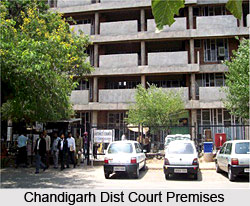 The District Courts of India are authorized by a judge. They govern justice in India at a district level. These courts are under governmental and judicial control of the High Court of the State to which the district concerned belongs. In each district, the highest court is that of the District and Sessions Judge. This is the principal court of civil jurisdiction. District courts are also court of Sessions. Sessions-triable cases are tried by the Sessions Court. It has the power to impose any sentence including capital punishment. There is a three tier system of courts. On the civil side, at the lowest level is the court of Civil Judge (Junior Division). On criminal side the lowest court is that of the Judicial Magistrate. Civil Judge (Junior Division) decides civil cases of small economic stake. Judicial Magistrates decide criminal cases which are punishable with imprisonment of up to five years.
The District Courts of India are authorized by a judge. They govern justice in India at a district level. These courts are under governmental and judicial control of the High Court of the State to which the district concerned belongs. In each district, the highest court is that of the District and Sessions Judge. This is the principal court of civil jurisdiction. District courts are also court of Sessions. Sessions-triable cases are tried by the Sessions Court. It has the power to impose any sentence including capital punishment. There is a three tier system of courts. On the civil side, at the lowest level is the court of Civil Judge (Junior Division). On criminal side the lowest court is that of the Judicial Magistrate. Civil Judge (Junior Division) decides civil cases of small economic stake. Judicial Magistrates decide criminal cases which are punishable with imprisonment of up to five years.
There are many courts that are subordinate to the court of District and Sessions Judge. There is the Court of Civil Judge (Senior Division) on the civil side and the Court of the Chief Judicial Magistrate on the Criminal side who are found at the middle of the hierarchy. Civil Judge (senior division) can decide civil cases of any valuation. There are many additional courts of Additional Civil Judge (senior division).The Jurisdiction of these addition courts is the same as that of the principal court of Civil Judge (Senior Division). The Chief Judicial Magistrate can try cases which are punishable with imprisonment for a term up to seven years. Usually there are many additional courts of Additional Chief Judicial Magistrates. At the top level there may be one or more courts of additional district and session judge with the same judicial power as that of the District and Sessions judge.
Judicial independence of each District courts of India is the characteristic feature of the district judiciary. In each district there is a strong bar which ensures that courts decide cases according to law and without fear or favour.




















